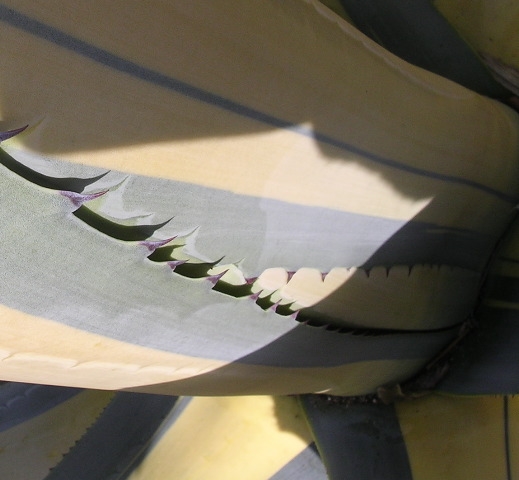The title of my poem Evaporated may not suggest it, but I drew its imagery draws the different contrasting botanical areas at the Huntington Gardens in San Marino. It has been one of my favourite places to visit ever since I first came to Southern California in 2005. The 207 acres of space, of which 120 acres are landscaped parks and gardens, showcase a variety of botanical areas. One of the most fascinating ones – probably for any European or East-coaster – is the ten-acre large desert garden which features more than 5,000 species of succulents and desert plants.
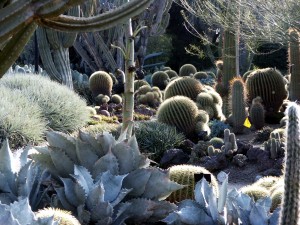
Succulents have always fascinated me, their shapes and characteristics and their ability to survive on so little and yet be able to bloom and flourish in the most extraordinary ways. As a teenager, I had a small collection of cacti: My room faced South so out of thin planks of wood I constructed swing-like benches for the large window for them to sit on and relish the sun rays. They were small and very common species but they sometimes even bloomed. But never did I expect to see such alien monstrosities or small insect-like clusters of cacti like I did at the Huntington gardens years later.
After having completed the poem I started to think about how, throughout my life, the experience of different landscapes and topographies has influenced my perception and awareness of my surroundings. Especially when living in a city, visits to gardens and urban parks have not only sometimes saved my sanity but also influenced my work as an artist and writer. The following piece for instance, which I recorded on my first solo album, I wrote after a visit to the beach in Santa Barbara. It’s short and melancholic, almost like a tone poem:
Listen to Pebbles in my Hand here:
My personal experience is that nature, even in contrived areas like in parks and gardens, can evoke emotions in us that are often not released otherwise. And it is a widespread and well-researched fact that nature leads to increased mental health and psychological development.
It was only after I had moved to Los Angeles that I became aware of how vastly different not only cityscapes but also landscapes can be, how much the climate can hinder or support certain activities. On the whole, I realized, I had been lucky to have spent the first three decades of my life in very green, fertile, and geographically non-threatening environments – no black widow spiders, earthquakes, mudslides, or mountain lions. But I can also see that not everyone in this city is able to make these choices and therefore experiences.
In most parts of the city of Los Angeles, there is no alternative to street culture. The city has paid little attention to small urban green spaces that should be available for all members of society, either within walking distance or at all times fully accessible by public transportation and an integral part of daily life. Some studies even show that “there is an obvious correlation between poverty, food access and lack of open space” like stated in a blog entry posing the question “Is the lack of recreational space making us fatter?”.
Parks and Gardens in Northern Europe
Having grown up in England as a child, the long history and culture of the English garden and park and my family’s interest in their natural surroundings influenced my relationship with and awareness for nature, whether in a natural or a contrived state. With my parents, we visited some of the most interesting estates, strange sculpture gardens, and vast parks, like the famous Hyde Park in London. My Nanna was a passionate gardener and cook, who made jam from her home-grown black currants and pies from her apples and even managed to grow some figs and tobacco on her large allotment in Suffolk.
After I was literally “deported” to Germany as a pre-teen, I felt that the flat and boring landscape, dotted with stoic, grass-munching cows, was a hard contrast to the hilly and lush countryside of East Anglia. I have tried to convey some of these emotions in a yet unfinished piece ‘Wasteland’, playing with these landscape features as synonyms for my interior landscapes. Nevertheless, nature was accessible and if it hadn’t been for the trauma of being moved away from my family, it would have been a theoretically non-threatening experience.
As a student, I then moved to the city of Hamburg. Perhaps it was a mere coincidence that Hamburg ranks as one of the top ten greenest cities in Germany and was awarded The by the European commission in 2011. But I truly enjoyed the fact that even though it rains a lot of the time (which can be depressing on another level and obviously helps the vegetation to flourish) there are so many green spaces, rivers, and canals accessible from all parts of town, mostly in walking distance.
Los Angeles’ National Parks
During my time here in Los Angeles I have therefore sought out many of the parks the County has to offer, like Griffith Park, situated in the Eastern Santa Monica Mountain range, in the northeastern part of the city.
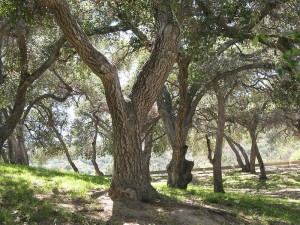
With over 4,210 acres of both natural Chaparral-covered terrain and landscaped parkland and picnic areas, it is the largest municipal park with urban wilderness area in the United States. Two famous landmarks are the recently restored observatory, opened to the public in 1935, and the Greek theatre, the famous music venue.
Represented in Griffith Park – in a similar way to Topanga State Park in Pacific Palisades – are California native plants and in small quantities, even some threatened species.
Franklin D. Roosevelt had already seen the health benefits of national parks and became an energetic supporter as president. He wrote:
There is nothing so American as our national parks. The scenery and the wildlife are native. The fundamental idea behind the parks is native. It is, in brief, that the country belongs to the people, that it is in process of making for the enrichment of the lives of all of us. The parks stand as the outward symbol of the great human principle.
He obviously also had a strong nationalistic agenda: Even in the midst of the Depression, national parks were being dramatically improved by Roosevelt’s Civilian Conservation Corps and highly publicized and therefore politicized. I doubt whether the city of Los Angeles is currently really interested in designing and financing green urban spaces in low-income zones.
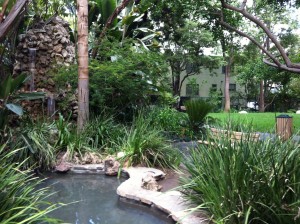
In middle-class neighbourhoods, like West Hollywood public parks, if existent, are tiny and still rare – like a small oasis nearby our home on King’s Road (very much the opposite of King’s Road in London…).
It features a beautiful small waterfall (I doubt whether from a natural water source), a Gingko tree, and tropical shrubbery, like banana plants and Bird of Paradise. It would, at the most, hold 50 people, tightly seated attending a one-woman flute concert. But on my almost daily dog walks it is a small oasis where I often sit down on one of the park benches, switch my iPod off, and can find tranquility.
Los Angeles’ Historic Parks and Gardens
Other communities that have long histories of parks surround Pasadena, a small college city about twenty miles north-west of Los Angeles that is famous for the annual Rose Parade, its craftsman houses, like the Gamble house by the architects Greene and Greene and the Millard house by Frank Lloyd Wright from 1923.
Nearby, in La Canada Flintridge are the Descanso Gardens which are well worth a visit throughout the year, but especially in January and February when the Camellias are in bloom.
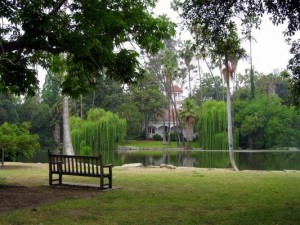
Located in the city of Arcadia, the Arboretum is home to plant collections from all over the world, including many rare and endangered species. The Arboretum also houses some interesting outdoor historical landmarks, like a Victorian Queen Anne cottage, representative of the major phases of California history. And like mentioned above the Huntington in San Marino whose desert gardens I am so fascinated by.
But unless you live in San Marino, ranked by Forbes Magazine as the 63rd most expensive area to live in the United States and where the median list price of a single-family home is almost 2 million US dollars you will always require private transportation to these places (unless you can afford a taxi).
These national parks and historical gardens are exclusive and exclude suburban oases. There is no train and hardly any busses. The entrance fee per adult (without an annual membership) is at the Huntington’s a staggering $20. So especially with a family these trips involve a steep budget, planning well ahead, and/or making reservations for the one free day of the week.
“It Never Rains in California”
Most people tend to perceive the Southern Californian climate as extremely friendly. They think of the beaches, of blonde and bronzed surfer dudes, of a place where it never rains. How often do you see tourists in an open tour bus without sunscreen and a hat – we all know that they’ll be close to a sunstroke by the time they’ve passed the 28th villa in Beverly Hills in which Barbara Streisand is supposed to have lived.
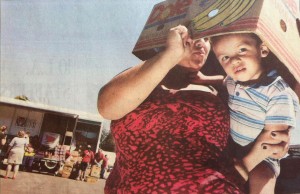
Being here all year round has made me realize that the sun can be very cruel and relentless. In August and September, I find it almost impossible to walk anywhere – it is the desert sun.
Unlike residential areas close to places like Griffith Park or the Huntington Gardens, the poorer parts of the city, like Compton or Torrance, offer hardly any escape from the desert-hot sun or relief from everyday problems and anxieties in a rejuvenating environment.
Not only green areas, like parks and gardens are missing but a large part of Los Angeles’ inner cityscape doesn’t even deliver much shade. Partly because a lot of areas lack trees with foliage (palm trees grow best) and, because of earthquake danger, the buildings are mainly low-rise complexes and strip malls. The wide streets are barren and dry, dusty and often excruciatingly un-embracing, uninspiring and insular.
The Problem with Urban Heat Islands
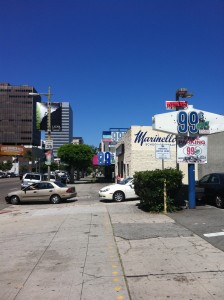
When the sun most violently smacks down on the dark asphalt and heats up its environment up to four degrees Fahrenheit more than in green areas, so-called urban heat islands are created.
Urban heat islands not only decrease the air quality but have an impact on nearby water bodies. But not only does Los Angeles lack public green areas that could be integrated into our daily lives and routines, but sources of water.
The only canals I know of are in Venice beach, surrounded by some of the most expensive real estate. The L.A. River is less picturesque with its concrete beds which act as water basins for melting snow gushing down the mountains in the spring. In the hot summer months, they are mostly dry.
Unlike in places like London with the River Thames or Paris with the romantic Seine, these areas are also not offered as spaces of contemplation or restoration in the middle of the city, mainly because they completely lack natural vegetation or wildlife.
It is a known fact that enclosing shrubbery and the foliage of trees in parks can foster crime, which is why some city planners have argued against them. Central Park in New York has (perhaps falsely) become a synonym for heinous acts of crime – like those often depicted on TV. But studies have also proven the opposite: Next to the urban study departments of many Universities, the APA, the American Planning Association, an independent, educational non-profit organization has conducted research programmes that show:
Time spent in natural surroundings relieves mental fatigue, which in turn relieves inattentiveness, irritability, and impulsivity, recognized by psychologists as precursors to violence. Green spaces also support frequent, casual contact among neighbors. This leads to the formation of neighborhood social ties, the building blocks of strong, secure neighborhoods where people tend to support, care about, and protect one another.
(c) Frances Livings 2011. All Rights Reserved.
